Almost all appliances in a modern apartment are powered by electricity. The location of light switches and sockets for electrical appliances, the correct laying of electrical wiring in the apartment - a guarantee of not only comfort in everyday life, but also a guarantee of safety against short circuits and fires.
Any renovation in an apartment must begin with planning the location of the main electrical appliances, creating diagrams and then laying the wires. In this article, various options for wiring diagrams will be analyzed, the pros and cons of one solution or another, step-by-step instructions for competently laying the wiring.
The content of the article:
- Creating a wiring diagram
- Tips for the correct combination of electric points
-
Instructions for laying electrical wires
- Step # 1 - examining schematic requirements
- Step # 2 - performing wire routing
- Step # 3 - layout of the apartment
- Step # 4 - laying electrical cables
- Conclusions and useful video on the topic
Creating a wiring diagram
In new apartment buildings, the common electrical network is connected only to the apartment. The entire layout of the electrical network inside the apartment is already performed by the owner, depending on the developed layout of furniture and electrical appliances. This is convenient, because owners of apartments with a ready-made network will have to partially or completely dismantle the old one in order to change it.
Make up wiring diagram in the apartment and it is possible to carry out its installation independently, or by entrusting this matter to specialists. The second option requires a fairly expensive investment, but it is worth remembering that working with electricity is life-threatening.
If you do not have certain skills, then it is better to entrust the installation to electricians, while the wiring diagram can be drawn up independently.
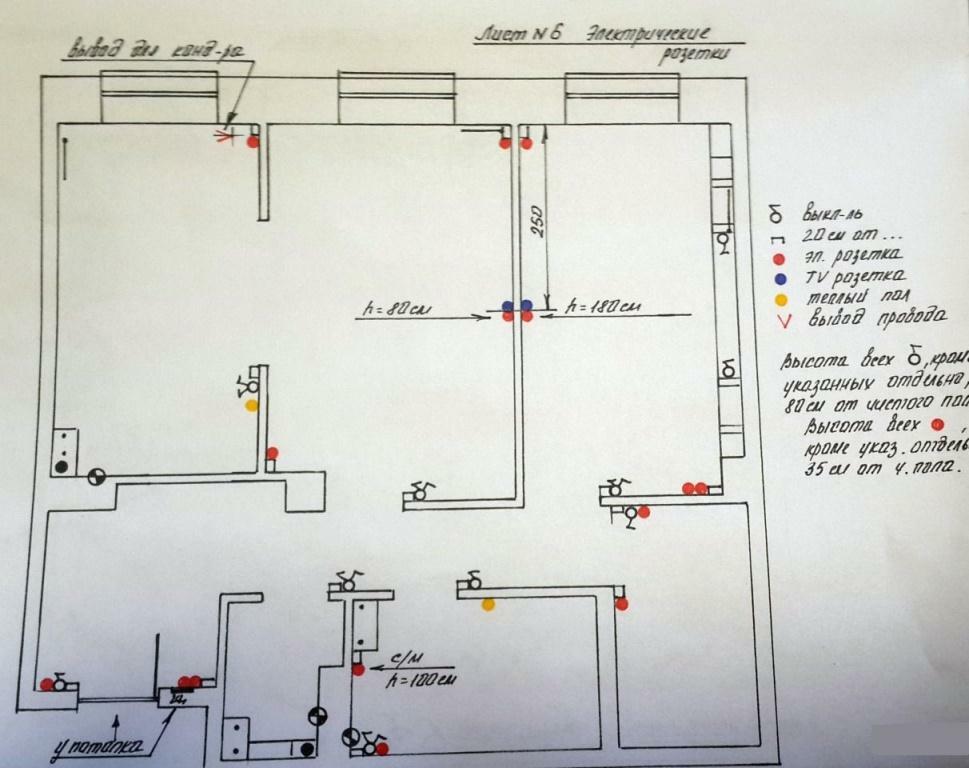
The scheme can be performed on a small piece of paper, however, it is imperative to apply all the elements in accordance with generally accepted designations
Any installation begins with the development of a future wiring diagram.
But before that it is necessary:
- think in detail about the placement of all electrical equipment and electrical appliances in the apartment;
- find the best places for the location of switches and sockets;
- depending on the location of the windows and natural lighting, choose the points for the placement of chandeliers and other lighting fixtures;
- calculate the required footage of the conducted power line and the number of electrical outlets on the scale of the entire apartment.
The planning process does not have to be fast, it is a very important step and must be taken seriously. Indeed, in case of miscalculations at this stage, in the future, it will be necessary to install furniture not as conveniently, but since it will correspond to the location of the sockets. Or use extension cords, which will litter the apartment with their wires and interfere with free passage.
After solving the issue with the location of furniture and electrical appliances, you can start creating an electrical circuit. The drawing should be as detailed as possible and drawn up to scale. To do this, you can take a plan-diagram of an apartment, on which all the main parameters of the rooms are indicated, or with the help of a ruler and a pencil, you can independently transfer the plan of the apartment to a sheet of paper. In this case, in the diagram, in addition to the intended location of objects, it is necessary to designate door and window openings.
When the plan of the apartment itself is drawn up, we proceed to the next stage - the location of the electric points and wiring lines. It is worth noting that all output elements from the common network are considered electric points, that is, sockets, switches, light sources operating directly from the network, junction boxes.
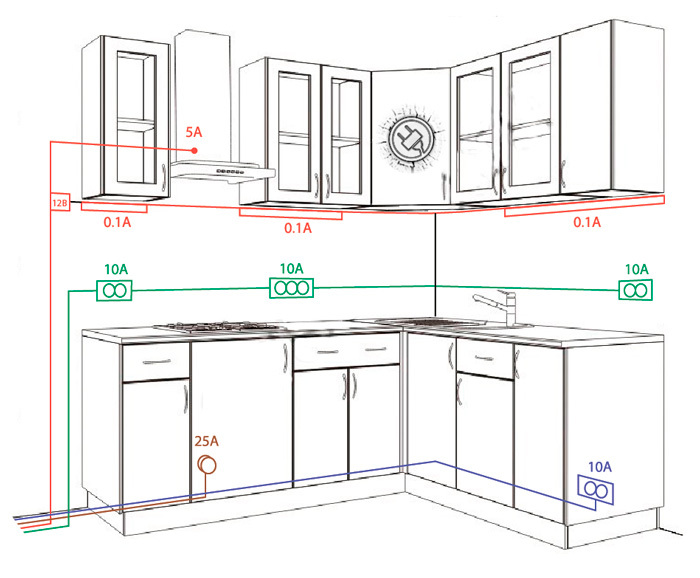
You can create a diagram using special programs such as archicad or Adobe Illustrator. However, using these programs requires certain skills that specialists have. But, such schemes will help to visually assess the future location of the electric points in the apartment.
From the point of view of daily operation and convenience in the event of malfunctions, the best option is the distribution of electrical outlets along separate wiring lines. The type of such distribution is called "loopback", it will be discussed later in the article.
The diagrams with the utmost accuracy must be marked:
- Shield, from which the main conductor of the electrical wiring line is drawn to the apartment.
- Routes of cables to be laid. The main rule that must be followed when laying the cable is its strict horizontal and vertical arrangement. Also, the distance from ceilings and openings should be at least 20 cm.
- Junction boxes - are considered the main connection point for cables inside the apartment. With proper distribution of the electrical network inside the apartment, they should be located on each branch of the network line. Thus, junction boxes should be in each of the living rooms, corridor, kitchen.
- Sockets - there can be any number of them. The legislation does not limit the number of sockets that can be in the apartment. However, when calculating their location, it is worth considering the location relative to doors, windows, batteries and pipes, gas pipelines. So, they can be located in any convenient place, but not less than 20 cm from the openings of doors and windows and 40 cm from gas pipelines, batteries and heat pipelines.
- Switches. Their location is also not regulated by the legislator in any way and completely depends on the desire of the designer. It is most convenient to place them no higher than the level of the head (on average 150-170 cm from the floor), or in the area of the hand with the hand down (50-70 cm from the floor). The location relative to the doorway does not matter and can be either right or left, depending on whether the owner is left-handed or right-handed and how it is more convenient for him to turn on and off the light.
- Sources of light, which can be located in any convenient place, both on the ceiling and on the walls. Their number is also not limited and depends on the illumination of the rooms and the designer's desire to illuminate a particular corner of the apartment to a greater extent.
A well-executed layout of electrical points and wiring lines will allow you to freely navigate in the future when laying apartment wiring.

The use of symbols when creating a diagram will help in case of further referral to specialists. So they can make out what the author intended.
Tips for the correct combination of electric points
To create an effective wiring in an apartment, it is necessary to distribute different directions and combine groups of electric points in these directions.
So, for laying electrical wiring from an electrical panel, it is worth highlighting the following lines:
- lighting for living rooms, kitchen and corridor;
- power supply to living rooms;
- separate power supply to the kitchen;
- lighting and power supply for bathroom and toilet;
- separate power line for electric stove and appliances consuming high power.
Each group will need to install a special residual current device, which will promptly disconnect a specific line, which will save the wiring and the equipment powered from it from damage.
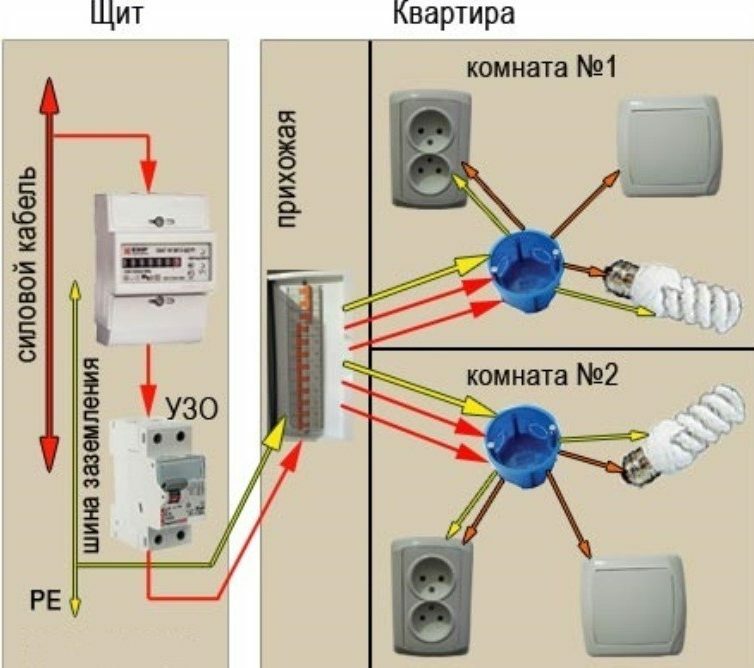
When combining electrical outlets, you should definitely use junction boxes, since they, first of all, are one of the ways to isolate connections
It is worth noting that the connection of the electrical panel to the power lines in the apartment must be entrusted to electricians. management companies, since this work must be performed exclusively by specialists in accordance with the requirements of legislative documents.
Instructions for laying electrical wires
Before drawing up a diagram and starting installation work, you need to familiarize yourself with a number of documents regulating the location of the electrical wiring in the apartment from the point of view of fire safety and safety for human life in the process exploitation.
Step # 1 - examining schematic requirements
Basic requirements and prohibitions when laying wiring in an apartment:
- it is forbidden to connect grounding of sockets to neutral wires or to water supply and heating systems - grounding must be connected only to the grounding bus;
- compulsory observance of the vertical and horizontal arrangement of the routes of the power lines;
- avoid crossing the lines of wires relative to each other, the trajectory of the laying should be performed as conveniently as possible from a household point vision, so as not to accidentally break through the wires when carrying out minor repairs or installing any equipment on walls;
- the distance between parallel wires must be at least 5 mm;
- conduct wires to the sockets from the bottom, and to the switches - from the top;
- mandatory installation of a machine with a nominal value of 63A for apartments in which electric stoves are installed. More about choosing machines in this article.
The height of finding the routes of electric cables relative to the ceiling or floor is not legally regulated. However, from a household point of view, it is better to place them closer to the floor or ceiling in order to free up most of the wall surface for further use.
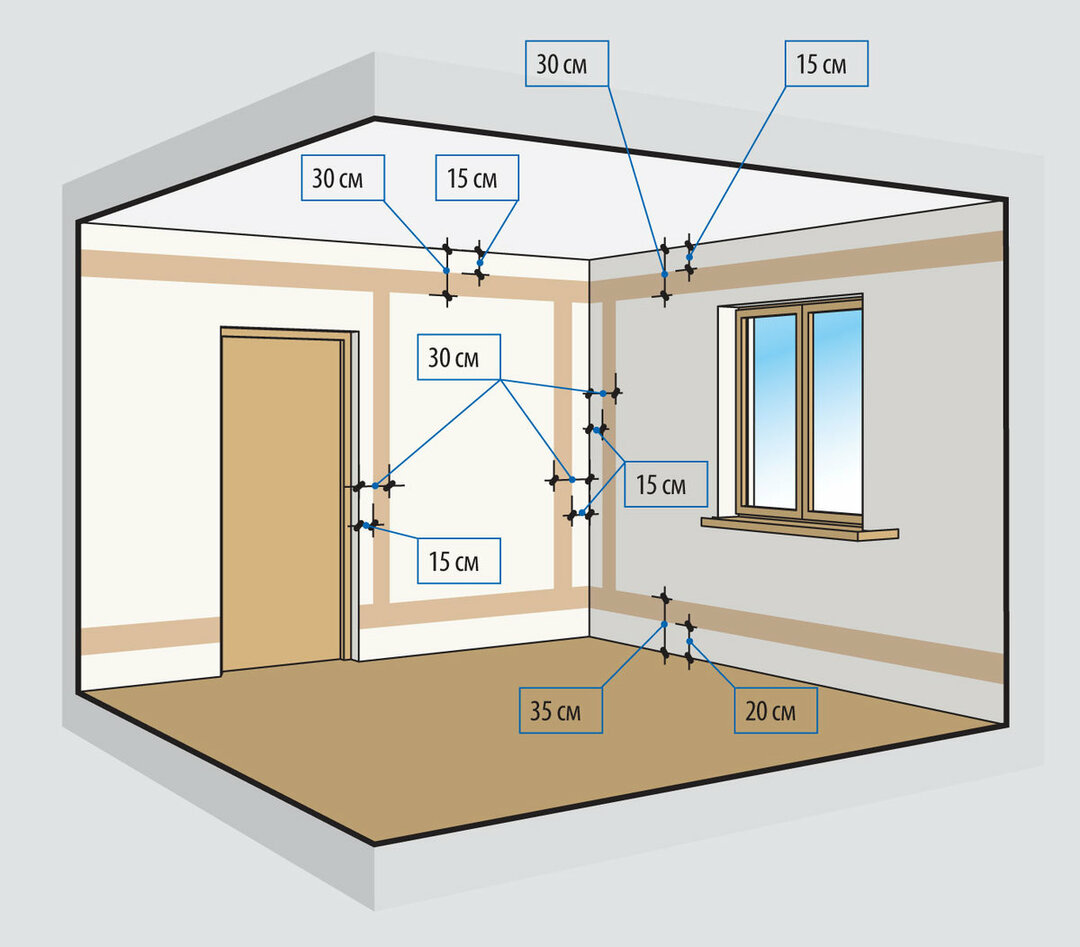
Compliance with the basic requirements will ensure the electrical safety of the laid electrical wiring and protect against short circuits and fires
Step # 2 - performing wire routing
There are several basic options for creating a working electrical wiring in apartments.
They are used depending on the type of apartment:
- star wiring;
- wiring type "loop";
- wiring using junction boxes.
Let's consider the features of each of these options.
Option # 1 - star wiring
"Zvezda" is convenient for laying electrical wiring in studio apartments or one-room apartments. Its peculiarity lies in the fact that a separate cable line is drawn to each electric point, which is closed to the central electrical panel.
The disadvantage of such a wiring is the high cost of the length of the electrical cable used and installation of an electrical panel big size. An advantage is the ability to control the operation of each element of the home electrical network.
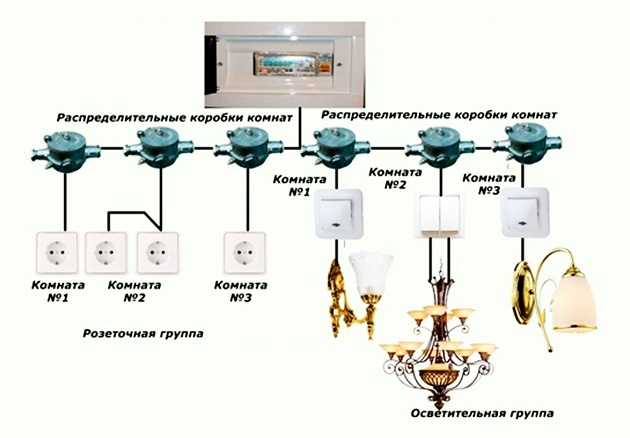
With such a wiring diagram, in the event of a malfunction of one of the electrical outlets, there is no need to completely check the entire household electrical network
Option # 2 - loopback wiring
The "loop" is similar in principle to the previous circuit, but at the same time several outgoing electric points can be closed to one line of the electric wire. This layout will be more economical and can be used in apartments with any number of rooms.
Also, this type of wiring makes it possible to quickly find malfunctions in the event of a failure of one of the electrical outlets, since they are broken and each brought to its own line. But, it should be understood that the load on the machine will increase depending on the number of electric points installed on one line.
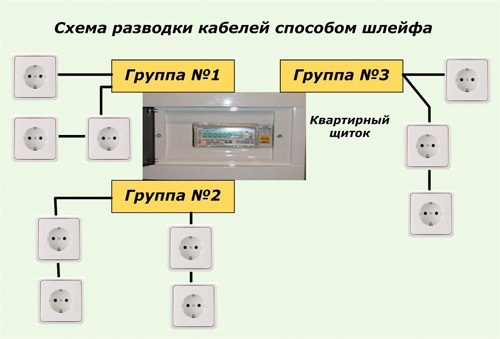
The loop wiring method was considered the main one for construction in the 20th century. He saved the length of the electrical cable, while retaining the ability to check a certain direction in the event of a malfunction of one of the electrical points
Option # 3 - junction boxes
The use of junction boxes is the most modern method of wiring in an apartment. The principle consists in conducting powerful conductors of electrical wiring from the main electrical panel to each of the rooms, where the redistribution of electrical wiring lines takes place in the distribution box.
To create an optimal electrical network inside an apartment, it is worth using all types of wiring at the same time. So, for example, conclusions for high-power electrical engineering and electric stoves are best performed in the "star" version, electrical appliances in the corridor provide the mains supply through the "loop" type wiring, and light, switches and sockets in living rooms can be performed using distribution boxes.
Step # 3 - layout of the apartment
After creating the circuit, several steps will follow for conducting electrical wiring inside the apartment. Each of them has features that must be strictly observed.
The second stage after drawing up the scheme is "markup". This is a very important stage, the essence of which is the exact transfer of the developed wiring diagram directly to its place in the apartment. That is, it will be necessary to apply marks on the surface of the walls, which, in accordance with the diagram, will in the future be the places of electric points and wiring lines.
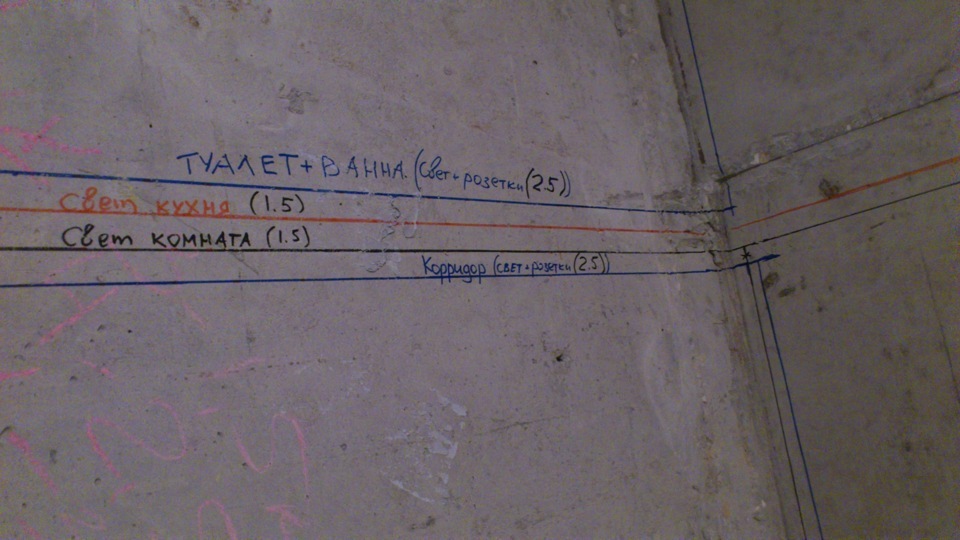
When transferring the scheme directly to the place in the apartment, it is worth using the same colors and designations. This will help you better navigate when starting work.
You need to do the markup as follows:
- designate the places where sockets and switches, light sources will be located;
- allocate places where cables will be output for TVs and a wi-fy router;
- designate the location of the junction boxes;
- determine and mark the places of the cable laying line from the junction boxes to each of the electrical outlets (along them, in the future, during installation, the walls will be channeled);
- determine the location of the routes of cable routes from the main apartment electrical panel to each junction box.
Carrying out the markup allows you to determine the correctness of the calculations on the diagram “on the spot” and finally fix the decision on such an arrangement of the electrical wiring in the apartment.
Step # 4 - laying electrical cables
There are several ways to lay the electrical wiring cable:
- hidden;
- open.
Let's talk about each option in more detail.
Method # 1 - hidden wiring
The first method is considered more time consuming, but it will allow you to hide all the cables inside the walls, which looks more aesthetically pleasing, and will not be conspicuous by the presence of boxes or open cables. For its execution, it is necessary gouge wallsby making grooves for the cables in them.
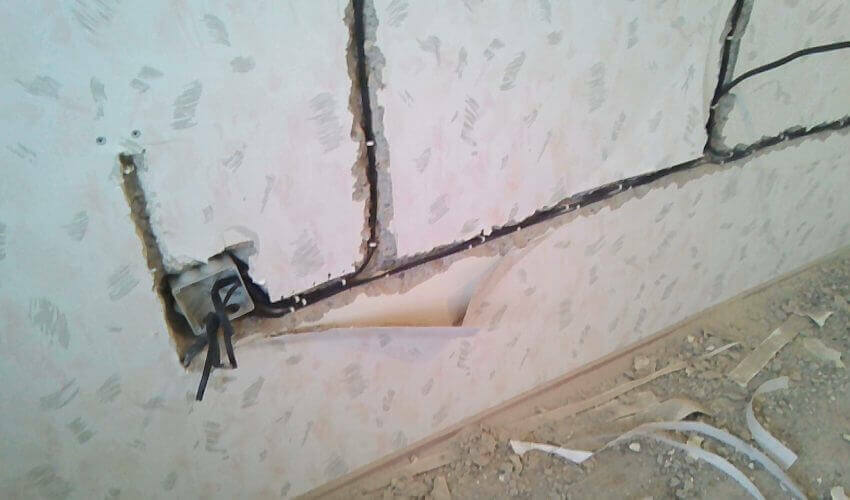
Concealed wiring protects the cable from external influences and possible mechanical damage, for example, by pets
Laying and further plastering will hide the electrical lines from the eyes. It is worth noting that when using this method, be sure to be careful, as damage to the cable can lead to a loss of electricity in the network section.
A more acceptable option for this kind of cable management is the installation of electrical wiring under the floor covering. In this case, it is imperative to enclose each wire in a corrugated tube, which gives it additional protection against damage.
It is important to remember that before you finally seal up the walls and floor, you need to check the serviceability of all the outputted electric points with a tester.
Method # 2 - open source
Open installation is suitable for apartments and premises where it is technically forbidden or impossible to run a wire inside walls or floors.
This is a simple installation, which is often carried out along the top of the apartment at the junction of the wall and ceiling. The cables are enclosed in special ducts or cable channels.
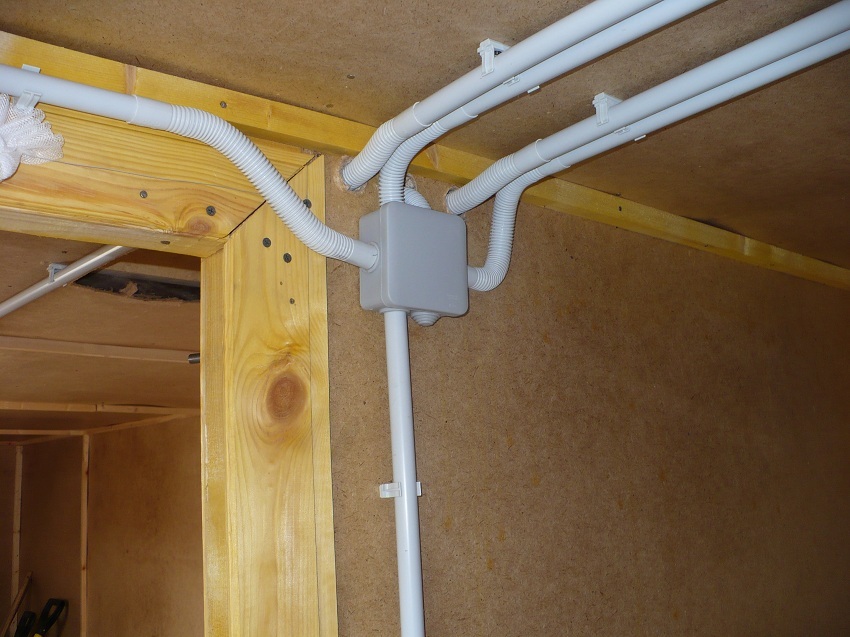
The open method is suitable for conducting wiring without major repairs in an apartment. So, for example, when installing electrical equipment that requires a separate outlet to the electrical panel
The main advantage of open installation is considered to be easy access to cable networks.
We talked in more detail about the installation of wiring from the shield in following material.
Conclusions and useful video on the topic
The creation of various wiring diagrams, as well as features, can be viewed in this video:
The independent implementation of the circuit and the installation of electrical wiring in an apartment is a solvable task, but it requires a careful study of the basics of electrical engineering. It is also advisable to study legend and rules for laying power cables. And it is better to entrust the work on conducting electricity in the apartment to professionals.
Creating a wiring diagram in an apartment is a creative process that must be carried out with special care and accuracy. The finished diagram should be clear and understandable enough so that any builder can understand and further implement what is shown in the diagram.
When drawing up a diagram, it is worth using the generally accepted designations of electric points and color highlighting of power lines and lighting and grounding wires. It is also mandatory to apply all distances and sizes that will help you better navigate when applying the markings directly in the apartment.
Do you have any questions about the topic of this article? Or do you want to share your personal experience in drawing up a diagram, installing electrical wiring? You can ask questions to our experts and other site visitors or leave recommendations in the comments section below this publication.


